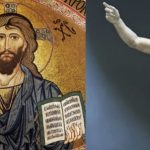Gutenberg’s Bible
On this day in 1456 Johannes Gutenberg’s first Bible was reportedly published. Sometimes called the 42-line Bible, it seems to have been the first book to be mass produced using movable type. His new printing press would of course change the world, and his invention unleashed a revolution which we are still impacted by today. Indeed, Time magazine in 1999 called Gutenberg the “Man of the Millennium”.
Admittedly, details are in dispute here (even as to the actual date of when the Bible was first printed), and history does not provide us with a full and fool-proof story of the man and his printing press. But as far as we can tell, his story goes something like this: Gutenberg (1398–1468) was the son of a wealthy German merchant, and began work as a blacksmith and goldsmith. He was also a great lover of books, which in his time were extremely expensive to own. Some volumes could cost as much as a farm.
Automated printing had already been available, beginning with the Chinese, and block printing had been around for at least a century. But Gutenberg revolutionised this process and made printing something both affordable and able to produce mass copies which were much more accessible.
He spent years working on his invention, and around 1450 his press was in operation, and he began working on the Bible. He had to borrow money to keep this process going, and that became part of his downfall. He went into business with Johann Fust, who later became impatient with his apparent lack of progress and his mounting debts, so he took him to court.
With no copyright or patent laws at the time, Gutenberg was averse to disclosing his secrets, and this led the court to decide against him. For a while Fust even claimed credit for the new Bible. But eventually credit went to where it was due, and today we look upon Gutenberg as one of the truly revolutionary figures of history.
His Bible, which may have in fact appeared in 1455, was sold for the equivalent of three years’ wages, but was still far cheaper than books had previously been. It is thought he may have printed 200 copies of his famous Bible, twenty in vellum and the rest in paper.
Containing 42 lines per page, it appeared in two volumes of 648 and 634 pages. Each copy was hand bound and individually illustrated. Today we have around 47 copies left of the Gutenberg Bible. Sadly, he died broke and largely forgotten a decade after his Bible burst on the scene.
But his legacy is indisputable. As Donald Brake writes, “By 1500, a mere thirty-two years after his death, Bibles from printing presses were found in seventeen European countries. Towns with presses grew to 260, and there were 1,120 printing offices. Almost four thousand different works in various editions totalling more than ten million copies had flooded the market. Clearly Gutenberg had an impact” (A Visual History of the English Bible, Baker, 2008).
And this revolution in printing is important for so many other reasons of course. Simply freeing up information and allowing ordinary people to get access to books and Bibles in their own languages was a remarkable achievement. It changed things fundamentally.
As Paul Johnson wrote in his A History of Christianity (Macmillan, 1976), without this invention the whole new movement in learning as found in Erasmus and the Christian humanists, the Renaissance, and the Reformers would never have gotten as far and as quickly.
This “New Learning” as historians call it would make for a radical break from the medieval church and state. Says Johnson, “The spread of the new knowledge virtually coincided with the technical development in printing. The coincidence ensured the development of both. The earliest printed books in the West were produced at Mainz in 1454-7, at the time Valli was annotating the Greek New Testament.”
He continues, “The rapid development of printing, with its tremendous concentration on works of seminal interest to religion and reform, posed an entirely new problem to the Church and State authorities which traditionally controlled the dissemination of knowledge. Censoring or preventing the circulation of printed books was essentially the same as controlling manuscripts; but the difference in speed and scale was absolutely crucial. It took at least a generation for the censors to tackle it, and they were never able to exercise the same degree of effective supervision as in the days before cheap printing….
“With the introduction of printing, the efforts of the censors became hopeless. Germany led the way. By the time Luther produced his own New Testament in 1522, there were fourteen different printed versions in German and four in Dutch; none contained a censor’s imprimatur or had been printed on a monastic press, but the attempt to forbid their circulation had been virtually abandoned. Erasmus not only welcomed this development but wished to extend the principle by bringing into existence a wholly literate laity with unrestricted access to all sacred writings.”
Historian Owen Chadwick in his important study, The Reformation (Penguin Books, 1964), also examines how the work of Gutenberg and others coincided with the New Learning: “The upper classes, the rulers, the merchants, were beginning to be better educated. The presses were working, the printers were multiplying, the libraries, though still tiny by later standards, were adding to the number and range of their books. The press made possible methods of study which were in embryo in the days of manuscripts. Texts could be compared, instruments of study acquired more cheaply, critical editions prepared, though the word ‘critical’ could not be used as it could in the seventeenth century, for the manuscripts still lay hidden in the library chests, and the methods of scholarship were not experienced. More people were reading books. Knowledge was increasing.”
In this and other ways history in the making was certainly occurring because of Gutenberg’s accomplishments. The invention of the printing press revolutionised Europe and the world. And in large part we owe it to a German printer who had a great love for books.
As I mentioned, it is impossible to get fully precise details on how all this happened, and when exactly. But if the 13th of March is indeed the date that the Gutenberg Bible first appeared, it clearly is a day worth celebrating and commemorating.
[1062 words]




















…and sadly today Andrew Bolt decides to attack the consistency and truths of the Bible…
http://blogs.news.com.au/heraldsun/andrewbolt/index.php/heraldsun/comments/which_genesis_story_should_christians_believe/
Annette Williams
Bill, did you see on Andrew Bolt’s blog this morning where he raises the old canards about the alleged contradictions regarding Luke’s nativity narrative (the “Quirinius problem”), and the two different accounts of creation in Gen.1&2? I’m afraid that for Andrew to be coming in on this one is a case of “a little bit of knowledge is a dangerous thing”. I have posted a response on his blog.
It seemed appropriate to do the same here, since Gutenberg’s Bible is a landmark in the history of printing, in the history of the Bible itself, and to compare and contrast the way back then people believed the Bible, where today many, many do not. And it’s not because “the scientific facts have refuted it”, but because the modern generation has latched on to a different story, i.e. evolution.
Murray R Adamthwaite
Thanks guys
Yes Bolt is a real worry when he wades into these areas. He is clearly out of his depth and simply embarrasses himself. Its a pity, because on other issues he can be quite good.
Thanks for putting in a reply on his blog Murray.
Bill Muehlenberg, CultureWatch
Dear Bill, Before Johannes Gutenberg did his masterwork, Bibles had to be copied by hand in scriptoriums. Now Christians (with religious liberty) have plentiful access to Bibles, daivatin stuti (a Malayalam term meaning “Praise the Lord”). Who speaks Malayalam? 10 million Christians in Kerala State, southern India. May many Christians study the Bible.
Regards, Franklin Wood
I always appreciate such important history Bill. I was reading recently about William Tyndale (choked,impaled and burnt on a stake for heresy by the “church”) excellent first English bible translated from the Hebrew and Greek text. This version undergirds the King James.
What I found fascinating was Tyndale’s insistence on being true to translation not to translate the Greek Ekklesia (which was a translation of a Hebrew word Kahal) into the English word Church (which comes from a similar root as the word circus) anywhere but used a far better word “community”. The writer of the article pointed out the word meaning was originally “Commonwealth of Israel” which is the gathered community of all the redeemed, both Jew and gentile. It appears KJ and his people had a vested interest behind using the word church (the translators were ordered they must use church) especially as KJ claimed he was it’s head. The puritans also rejected the word in favor of “Congregation”as did Luther who used community.
Taken from “The separation of Church and Faith” Daniel Gruber
Re Andrew Bolt, what a pity he put out such a view not knowing the facts, I wonder if he will put out a retraction since so many have posted on his blog correcting his error? I think Andrew lost the plot here.
Rob Withall
Murray, I have now done a piece on the Bolt article:
https://billmuehlenberg.com/2012/03/14/atheists-out-of-their-depth/
Bill Muehlenberg, CultureWatch